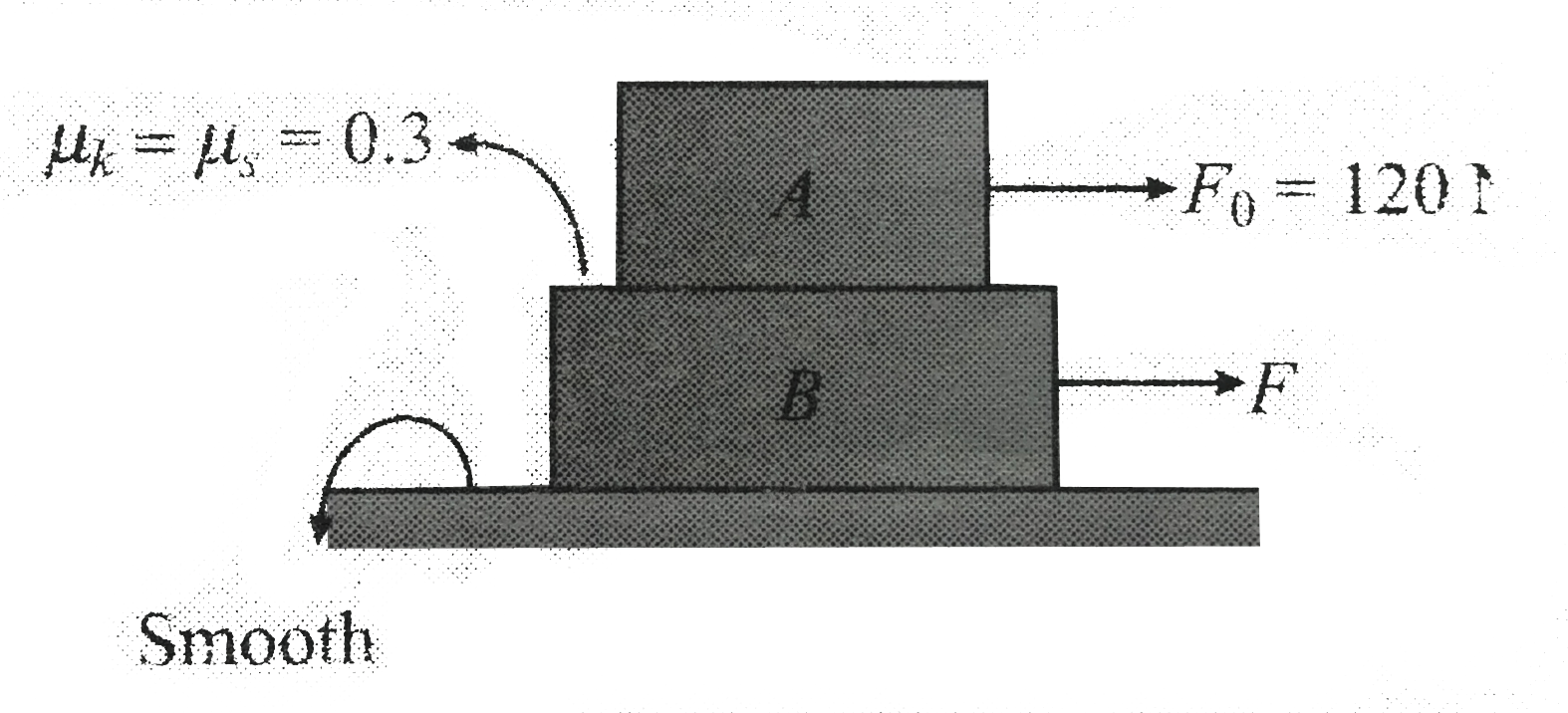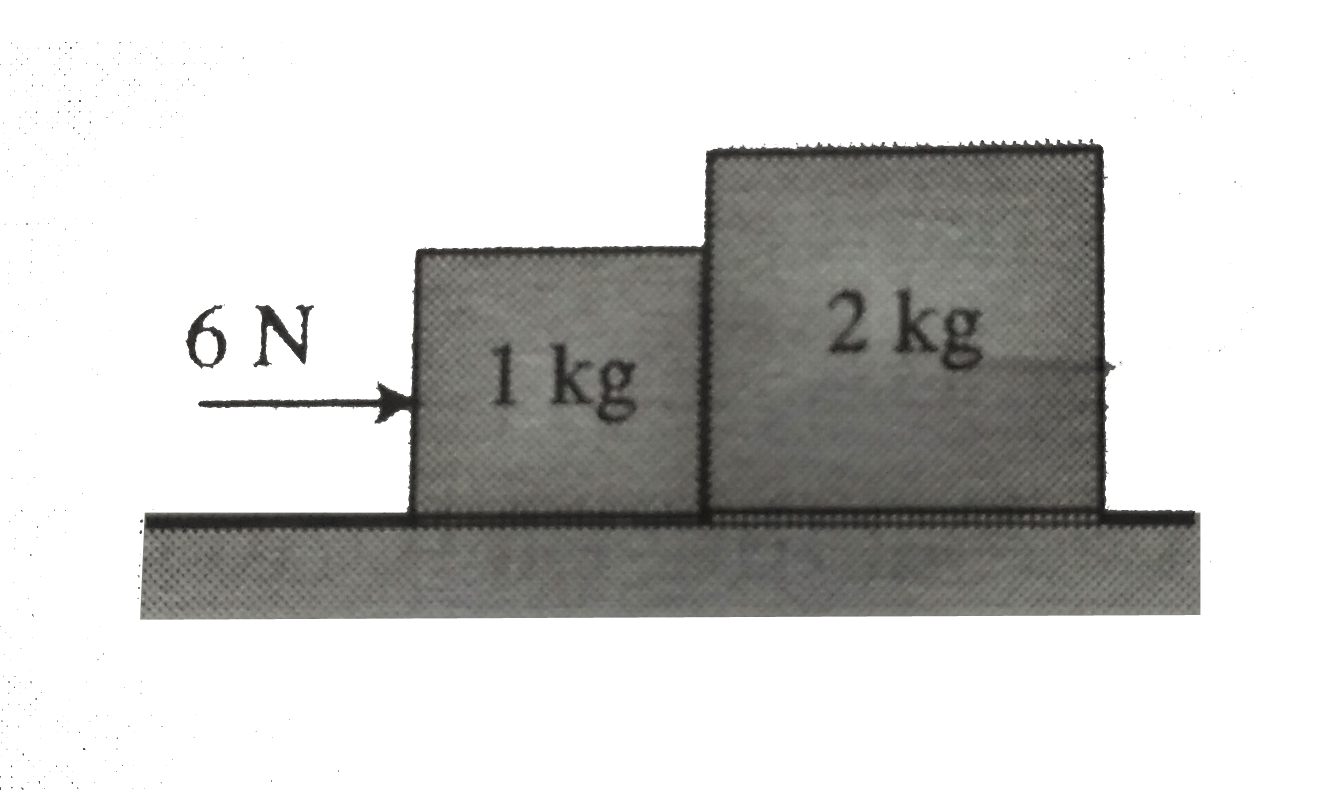Two blocks A and B of mass 10kg and 20kg respectivelly, are arranged as shown in figure In the figure given a constant force F0=120Nact on block A and a force F applied horizontally on block B is gradually increased from zero. Discuss the direction and nature of friction force and the acceleations of the block for different value of F

If the above situation , we see that the maximum possible value of friction between the block is
fmax=μsmAg=0.3×10×10=30N
Case 1 : when F=0
Considering that there is no slipping between the blocks the acceleration of system will be
a=12020+10=4ms−2
From FBD of Bf=mBa=20×4=80N
But fmax=30N

We can conclude that the blocks do not move togather.
New drawing the FBD of each , for finding out individual acceleration

Acceleration of A
aA=120−3010=9ms−2 toward right
Acceleration of B
aB=3020=1.5ms−2 toward right
Case II: F is increased from zero till the two blocks just start moving togather .

As the two blocks move together , the friction is static in nature and its value is limiting FBD in this case will be
aA=120−3010=9ms−2
⇒aB=F+3020=aA⇒F+3020=9 or F=150N
Hence , when 0<F<150N , the blocks do not move together and the friction is kinetic Asd F increase, acceleration of blocks B increases from 1.5ms−2→9ms−2
At F=150N, limiting static frictionstatic acting and the two blocks starts moving togather
Case III : When F is increased above 150N In this scenario, the static friction adjusts itself so as to keep the blocks moving togather . The value of static friction starts reducing but the deriction still remain same This direction still the value of friction becomes zero In this case , the FBD is as follows

aA=aB=120−f10=F+f20
Therefore when the friction force f gets reduced to zero , the above acceleration become
aA=120−1010=12ms−2⇒aB=F20=aA=12ms−2
∴F=240N
Hence when 150N≤F≤240N the static friction force continously decreases from maximum to zero at F=240N , The acceleration of the blocks increases from 9ms−2 to 12ms2 during the change of force F
Case iv : when F is increased again from 240N The decrease of friction firce on the block reveeses but it is still static F can be increased till this reverse static friction reaches its limiting value FBD at this jucture will be The blocks move togather , therefore

aA=120+3010=15ms−2
⇒aB=F−3020=aA=15ms−2
∴F−3020=15ms−2
Hence F=330N
Case V: When F is increased beyond 330N In this case . the limiting friction is achived and slipping takes place .
Topper's Solved these Questions
- BOOK - CENGAGE PHYSICS ENGLISHCHAPTER - NEWTON'S LAWS OF MOTION 2EXERCISE - Solved Examples12videos
NEWTON'S LAWS OF MOTION 2
- BOOK - CENGAGE PHYSICS ENGLISHCHAPTER - NEWTON'S LAWS OF MOTION 2EXERCISE - Exercise 7.125videos
NEWTON'S LAWS OF MOTION 2
- BOOK - CENGAGE PHYSICS ENGLISHCHAPTER - NEWTON'S LAWS OF MOTION 1EXERCISE - Integer5videos
NEWTON'S LAWS OF MOTION 1
- BOOK - CENGAGE PHYSICS ENGLISHCHAPTER - PROPERTIES OF SOLIDS AND FLUIDSEXERCISE - INTEGER_TYPE2videos
PROPERTIES OF SOLIDS AND FLUIDS
Similar Questions
Two blocks A and B of masses 2kg and 8kg respectively are kept in contact and pressed against a roguh vertical wall by applying a horizontal force F=50N as shown, The frictional force acting between the two blocks is
 View Solution
View SolutionA force of 50N acts in the direction as shown in figure. The block of mass 5kg, resting on a smooth horizontal surface. Find out the acceleration of the block.
 View Solution
View Solution
Knowledge Check
- Question 1 - Select One
Two blocks of masses 10 kg and 20 kg are connected by a massless string and are placed on a smooth horizontal surface as shown in the figure. If a force F=600 N is applied to 10 kg block, then the tension in the string is
 A100NB200NC300ND400N
A100NB200NC300ND400N
A force of 50N acts in the direction as shown in figure. The block of mass 5kg, resting on a smooth horizontal surface. Find out the acceleration of the block.
 View Solution
View SolutionTwo blocks of masses 1 kg and 2 kg are placed in contact on a smooth horizontal surface as shown in fig. A horizontal force of 6N is applied d(a) on a 1-kg block. Find the force of interaction of the blocks.

 .View Solution
.View SolutionIf in pervious problem, an additional force F'=100N is applied in vertical direction as shown in figure The friction force acting on the block is
View SolutionA block of mass 10 kg is moving on a rough surface as shown in figure. The frictional force acting on block is :-
 View Solution
View SolutionTwo blocks of masses 4kg and 2kg are placed side on a smooth horizontal surface as shown in the figure. A horizontal force of 20N is applied on 4kgblock. Find
(a) the acceleration of each block.
(b) the normal reaction between two blocks.
 View Solution
View SolutionTwo blocks of masses 4kg and 2kg are placed side on a smooth horizontal surface as shown in the figure. A horizontal force of 20N is applied on 4kgblock. Find
(a) the acceleration of each block.
(b) the normal reaction between two blocks.
 View Solution
View SolutionA force of 100N is applied on a block of mass 3kg as shown below. The coefficient of friction between wall and the block is 1/4. The friction force acting on the block is :
 View Solution
View Solution
